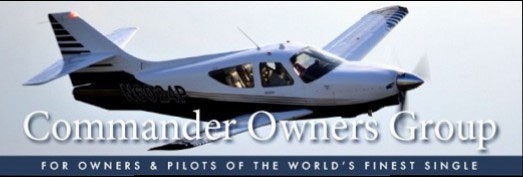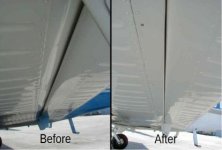Hi Carl and All,
VERY IMPORTANT
Set the flaps at the high end of the rig range, explained as follows:
During installation of the flap seals, the flaps must be set at the top of the rig range. The rig range is 11.5 +/ 1 degrees thus the top of the range (the highest position of the flaps) is 10.5 degrees. This angle is referenced to the belly pan just aft of the the nose gear well. On most airplanes, getting the flaps up to this position will require some reforming of the wing trailing edge in the no-step area due to sunken edges from too many step ups. After installation of the seals, the flaps can be returned to their original rigging, or re-rigged for best handling and speed.
"Fit" the seals before installation, explained as follows:
For most airplanes, the seals will require some trimming before installation. With the flaps at the top of the rig range, make sure there is at least a positive air gap between the leading edge of the flap and the standing wall of the seal. If the seals are not "fitted" before installation, it is MUCH HARDER to correct them afterwards.
Install the brackets flat and rivets flush, explained as follows:
Be carefull to install the L brackets "flat" against the cove skins, trimming and/or backgrinding the brackets for any clearances needed for existing rivets, and countersinking properly for the bracket rivets so that the heads are flush and don't chafe your flap skins. It may be necessary to gently form the L's for a good compliance with the curvature of the cove skins.
The hard lesson:
I have a plane in shop at the moment with the seals mounted such that the left flap can only come up to 13.5 degrees before it makes hard contact with the seal along about half the length of the seal. This flap position is a full degree out of the the rig range on the low side (dragging) and thus about 3 degrees low of where I would like it to be at the top of the rig range. The loss of airspeed from this sloppy installation of the seals is much greater than any gain from having the seals in place.
Bottom line:
I think the seals are a worthwhile speed mod, but if installed without attention to these details, can become a great and continuing liability.
Carl,
I've been offering this advice for years, but continue to encounter airplanes I can't rig properly due to these factors, so I think a review of the instructions might be order to make sure enough attention is called to these issues. Feel free to call me for any futher clarification that might be helpful.
Owners,
Don't beat up your shop for the lowest price to install the seals. Instead, direct them to this advice, and ask them to do a careful and proper job. Else, just don't bother wasting your money.
Jim

